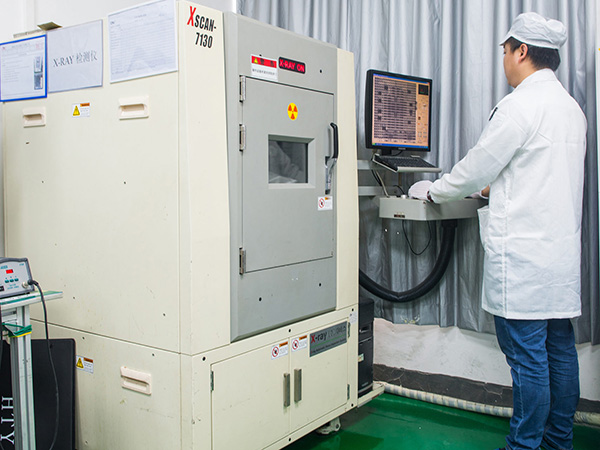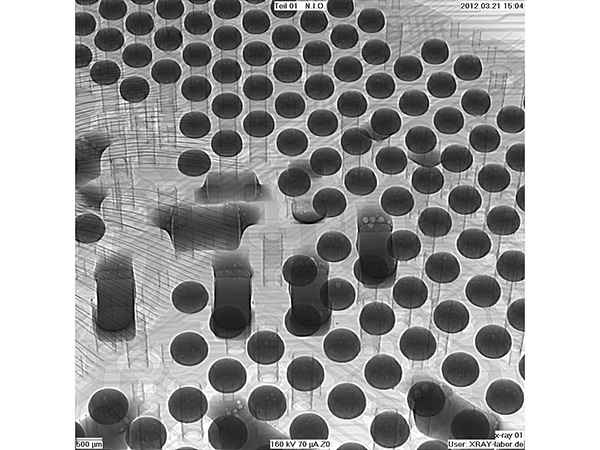
BGA Soldering in Makerfabs

Master surface mount electronics and you can build cool things. It's a fact. But many people still find ball grid array (BGA) intimidating. Makerfabs as a company specialising in PCB/PCBA assembly, we have considerable expertise in BGA soldering and are pleased to be able to share this with our customers.
lWhat is BGA Soldering?

BGA (Ball Grid Array) soldering is a technique used to attach integrated circuits (ICs) to a printed circuit board (PCB). In BGA packaging, the solder balls are arranged in a grid pattern on the underside of the chip. When the chip is placed on the PCB, the solder balls are melted during the reflow soldering process, creating strong electrical connections between the IC and the board.The process typically involves applying solder paste to the PCB pads, placing the BGA component, and then using a reflow oven to melt the solder and create the joints. After cooling, the connections solidify, ensuring a strong bond.
lWhy choose BGA Soldering?

BGA soldering offers several distinct advantages over traditional soldering methods, such as through-hole or surface-mount technology (SMT) using leads. Below are the key advantages:
1. Higher Pin Density
Efficient Space Utilization: BGA packages can accommodate hundreds or thousands of pins in a compact area.
Compact Design: Reduces the size of the IC, making it ideal for high-performance applications in smartphones, tablets, and laptops.
2. Better Electrical Performance
Shorter Signal Paths: Because the connections are directly under the chip, signal paths are shorter, which minimizes inductance and signal loss.
Reduced Crosstalk: The separation between solder balls reduces interference between connections.
3. Improved Thermal Performance
Better Heat Dissipation: The contact points (balls) provide a large surface area, helping with efficient heat transfer from the IC to the PCB.
4. Mechanical Strength and Reliability
Stress Distribution: Solder joints in BGA packages are more evenly distributed across the array, which reduces mechanical stress.
Reduced Lead Damage: No fragile leads that can bend or break during handling, unlike QFP or SOIC (Small Outline Integrated Circuit) packages.
5. Fewer Alignment Issues
Self-Centering Effect: During reflow soldering, the surface tension of the molten solder balls helps align the BGA automatically on the PCB pads, improving the chances of a proper connection.
6. Smaller and Lighter Components
Lightweight Designs: BGA packages are more compact and lighter, aligning with the trend of miniaturization in electronics
While BGA soldering offers numerous advantages, it also presents a number of challenges:
1.Complex Inspection and Repair: Visual inspection is difficult since the connections are hidden under the package. Specialised tools like X-ray machines are often needed to detect solder defects.
2.Precise Reflow Soldering Process: Requires controlled temperature profiles to avoid incomplete connections or bridging .
At Makerfabs, we have the expertise and the right equipment to carry out BGA soldering work for our customers. With many years of soldering experience and X-ray test equipment, we can guarantee the highest quality of work.
lBGA soldering at Makerfabs
1.The BGA packages with pins pitch can be 0.3mm in Makerfabs:

For the majority of PCBA factories, a 0.5mm BGA is a safe option. However, 0.4mm is considered to be a little risky, while 0.3mm is regarded as being dangerous in soldering quality control. As a result, the majority of PCBA vendors have set the BGA soldering capacity to 0.4mm.
In Makerfabs, the one-time pass rate for 0.4mm pitch BGA soldering is normally >98%, while 92%~95% for 0.3mm BGA soldering, as in our 5 years’ experience in dealing BGA soldering.
2.Inspecting BGA Solder Joints with X-rays in Makerfabs:




When BGAs were first introduced, there was great interest in the BGA inspection process. Using straightforward optical techniques to inspect BGA components is impossible since the solder joints are located beneath the BGA components and can’t be seen.By using X-rays for BGA inspection, the soldered joint can be easily inspected and tested. AXI(Automated X-ray Inspection ) became a popular technology for inspecting PCB assemblies that included BGAs after this development.
At Makerfabs we use X-rays to inspect BGA soldering for our customers, as shown in the images above.
3. How to charge for BGA soldering in Makerfabs:
The BGA soldering process requires a more precise stencil and places higher demands on the pick-and-place machine and reflow temperature. Consequently, the BGA soldering starting fee for a PCBA factory would be higher. If only samples are required, the soldering fee for a PCBA with BGA technology will be higher than for a PCBA without BGA.
At Makerfabs, the starting fee for a PCBA with BGA will be between $100 ~ $500, depending on the BGA pitch and the complexity of the designHowever, when the quantity required reaches the hundreds, the fees will be the same.
4.PCBA solder quality inspection in Makerfabs:


X-ray is an effective method for inspecting the quality of BGA soldering, but it is not a suitable approach for PCBA mass production due to the high cost and time required for testing. It is more appropriate for use as a quality control measure for BGA soldering samples .
For example, the pick-and-place operation must be functioning correctly, the tins must be melting properly at the specified temperature, and the sample and mass soldering must be satisfactory. The most effective and definitive method for ensuring the quality of the PCBA soldering is still the functional testing as we always do.
The BGA technology and soldering process have enjoyed remarkable success since their introduction, becoming integral to PCB assembly systems in most companies, both in mass production and prototype assembly.
As a company specialising in PCB/PCBA assembly, Makerfabs is pleased to offer customers expertise and services related to BGA soldering. If you require any assistance, please do not hesitate to contact us : )



 Previous
Previous 



